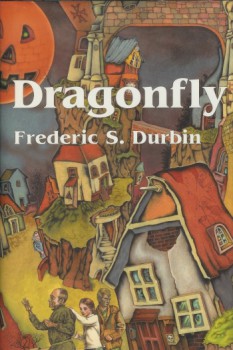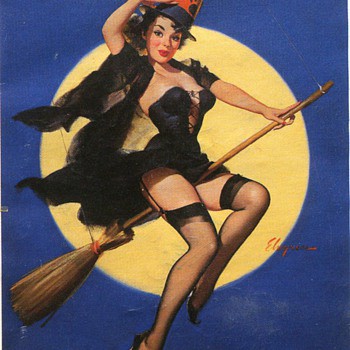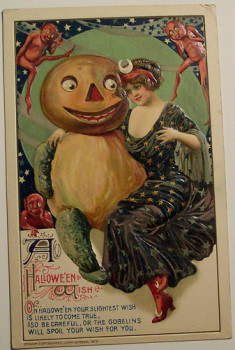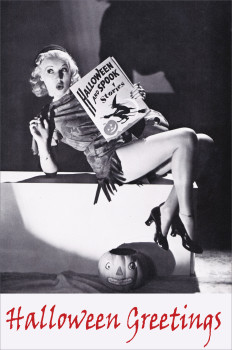Oz and Frederic S. Durbin Discuss Hallowe’en Monsters
 In response to my “Five Weeks of Frights” Hallowe’en post “Oz Meets the Scarecrow,” novelist and short-story writer extraordinaire Frederic S. Durbin sent me a thoughtful email, furthering an ongoing discussion of iconic Hallowe’en monsters. With his kind permission, I am reprinting it here.
In response to my “Five Weeks of Frights” Hallowe’en post “Oz Meets the Scarecrow,” novelist and short-story writer extraordinaire Frederic S. Durbin sent me a thoughtful email, furthering an ongoing discussion of iconic Hallowe’en monsters. With his kind permission, I am reprinting it here.
Consider it a guest post from the writer of the wonderful Arkham House novel Dragonfly (a quintessential Hallowe’en read) and — one of my favorite Hallowe’en short stories — “The Bone Man,” which ran in The Magazine of Fantasy and Science Fiction in 2007. Of course, he will also be familiar to regular Black Gate readers; his story “World’s End” was, according to John ONeill, “one of the most acclaimed stories in Black Gate 15.” Here’s Fred:
Fantastic post on the Scarecrow! That’s insightful — I’d been wondering what the next center-stage monster would be, and I would trust your impressions as one poised to see into various oncoming and now-arriving streams of the pop culture.
It’s interesting to ponder what about the classic monsters is at the center of the terror they hold for us.
1. The vampire is essentially Death. He comes from the graves. He feasts on the living. He gathers us unto himself.
2. The werewolf is the beast within us, the monster at the core of man. He is our fear of ourselves.
3. Frankenstein’s monster is our fear of our gifts, our behavior — what we might do when nothing is beyond our reach. We might steal fire from the sun. We might reanimate the dead. And the fire and the dead will bite us in the butts.
4. The zombie is our fear of illness. Alzheimer’s . . . global pandemic viruses . . . irreversible illness; it looks like our loved one, but it no longer is, and there’s no cure.
So what is the scarecrow? I think you’ve answered that question eloquently. Essentially, he’s the daddy of them all, the Last Boss, the overlord — because he is our fear of the unknown. I italicized that as an homage to Lovecraft, who told us what our greatest and strongest and oldest fear is.
Durbin went on to add a more personal note…
But something more resonated with me in your post — that part I’ve read before, in your introduction to Scott Dixon’s book. That feeling not simply of panic-like horror, but the horror that is a kind of sadness. I think I felt a twinge of that the other day, and I had never quite experienced the same thing before. As I reasoned it out then, I think it has to do with being newly married. All my life as a single man, I never feared death — when it will come, it will come, and I don’t believe it’s the end of anything but a veil. I was always more worried about the deaths of close loved ones than my own. Then when my parents died, I was sort of set free from that. I no longer had anything to fear from death. But then you marry a person — especially somewhat later in life, as I have — and you have someone to lose again, and you know that old age is no longer nearly as far off as it once was. Yes, I think I understand that sadness you described that is woven into the heart of the scarecrow’s fear.
When we were kids, my next-door neighbor/best friend Chris and I used to come up with scenarios, constantly trying to top ourselves, trying to come up with the scariest situations possible. They usually involved meeting inexplicable beings in lonely places. They always boiled down to — not an overtly threatening danger with teeth and claws, clearly bent on devouring us — but rather to something . . . some thing . . . that we did not at all understand, and we didn’t have any idea what it wanted or what it might do.
Although we didn’t call it such, I think we were also dealing with the scarecrow. The terror of the scarecrow is closely tied to the terror of the doll — the thing made by hands, yet in the shape of something that might be conscious and might live and move.
Interesting thoughts for October . . .
 Reading Durbin’s list of Hallowe’en monsters, I noted he’d excluded a couple: the mummy and the witch. I began to ponder what particular fears those archetypes embodied. Proving that great (or warped? pleasantly haunted?) minds think alike, Fred’s next email included this addendum:
Reading Durbin’s list of Hallowe’en monsters, I noted he’d excluded a couple: the mummy and the witch. I began to ponder what particular fears those archetypes embodied. Proving that great (or warped? pleasantly haunted?) minds think alike, Fred’s next email included this addendum:
There are the mummy and the witch to consider, too. I don’t know if I have any helpful thoughts about the mummy, but the witch seems to me a combination of two things:
1. our fear of external evil — danger prowling the night, which can hurt, curse, and blight us; the devil, who is the witch’s boss — evil that can both assail us and corrupt us, which leads to:
2. our repulsion at/attraction to our secret passions and desires; the imp within all of us who delights in wildness and wickedness and complete abandon; we fear the witch, but we want to be the witch, dancing naked under the moon.
As it turns out, our thoughts were running concurrently about these other two monster types and what fears they might embody. On the mummy, I postulated that maybe he fit in more broadly with one of the other categories, but he doesn’t fit nicely the way Mr. Hyde fits in with the Wolfman. He is a revenant, like a zombie, but he retains his consciousness and volition, like the vampire. So he is more akin to a vampire, drawing on the life-energy of others to restore vitality to his dry, withered flesh.
I’ll tell you one thing about the original Mummy movies: they are only good in the beginning, when unwitting archeologists release him from his tomb. Once he reassumes his human form and becomes some Svengali-like priest trying to resurrect his lost love or whatever, the films seem to jump genres from horror to suspense. He’s not a monster anymore, at least not on the outside; the movies were no longer spooky and I lost all interest in them. But the iconic mummy itself, when it shambles forth from its sarcophagus: on a visceral level, it confronts us with the dust and bones and shriveled, parchment-dry flesh we will all become. Zombies confront us with the horror of the immediate aftermath of decomposition, all wet guts and dripping goo; mummies embody a stage much further along in the process, when only the semblance of human shape barely remains, held together by wrappings, one step short of dust and ashes. The mummy, hmm…It is something ancient, but yet it still possesses power. The fear of old, powerful stuff that we don’t understand, that we have forgotten?
 Much more interesting to me is ye olde witch. I had taken a different tack in my reflections on her, the iconic old green hag with the broom, the black cat, and the wart nose. At least in this modern, western incarnation, she grows out of fears and superstitions of the Middle Ages — the patriarchal Middle Ages. So she seems to have embodied a fear of strong, independent women: a bogeyman for men.
Much more interesting to me is ye olde witch. I had taken a different tack in my reflections on her, the iconic old green hag with the broom, the black cat, and the wart nose. At least in this modern, western incarnation, she grows out of fears and superstitions of the Middle Ages — the patriarchal Middle Ages. So she seems to have embodied a fear of strong, independent women: a bogeyman for men.
As women have gained gender equality throughout the twentieth century, the witch has also been redeemed. As far as I can ascertain, the first appearance of a good witch in western literature occurs in 1900, with Glinda in The Wonderful Wizard of Oz (and I think it’s significant that L. Frank Baum was an early champion of women’s rights who often busted stereotypes with female protagonists in his books). Later on, you have the benevolent Witch Hazel (who still looks like the stereotypical witch), who comes to the aid of Huey, Dewey, and Louie against their mean-pranking Uncle Donald Duck in the 1952 Disney cartoon “Trick or Treat.” Then comes Bewitched in the ’60s.
 By the turn of the new century, a witch character is as likely to be the protagonist as the antagonist in shows like Buffy the Vampire Slayer, Charmed etc. The Harry Potter books, in which our characters are learning to be wizards and witches, became the best-selling books of all time and few people bat an eye (except for a few batty religious-right groups who conduct Harry-Potter book burnings, because they’re still seeing wizards and witches through the lens of the Middle Ages).
By the turn of the new century, a witch character is as likely to be the protagonist as the antagonist in shows like Buffy the Vampire Slayer, Charmed etc. The Harry Potter books, in which our characters are learning to be wizards and witches, became the best-selling books of all time and few people bat an eye (except for a few batty religious-right groups who conduct Harry-Potter book burnings, because they’re still seeing wizards and witches through the lens of the Middle Ages).
When I shared these musings with Fred, he responded with this observation:
This is interesting about the witch, and I think you are onto something. Although there were warlocks in history (for as long as there have been witches), they have never gotten the attention that witches have gotten (I think because wizards and sorcerers have overshadowed them as something else). The witch is really ancient, though — much older than Christianity. There’s the Witch of En Dor (a medium) that Saul consults in I Samuel 28. There are witches in classical myth — Circe, etc. All cultures have them, of course.
See, here’s an angle of the whole discussion to consider: for our purposes, I think we have to limit the treatment of these figures to their Western-world iconic Hallowe’enish manifestations. I’m not sure what the best way to word it is, but I think you see what I mean.
It’s like the way I treated Gypsies in Dragonfly. They’re not supposed to be real Gypsies — they’re Hallowe’en Gypsies, the Gypsies of The Wolfman.
But yes, you do make a good point about how the witch was a “bogeyman” for men, the lone specifically female figure among a cast of monsters predominantly male. But I would argue that, even at the height of witch persecution, there was (perhaps unspoken of, perhaps unrealized) an undercurrent of appeal to the witch — forbidden desire — which was very likely a reaction against that constraining, powerful Church that dictated so much of one’s behavior. We burn the witch for doing what we secretly wish we could do. Footnote to this — I wonder if a tiny bit of this phenomenon can be seen in certain modern anti-heroes such as Hannibal Lecter and characters in TV series like Dexter and Breaking Bad. We love to fear (and admire?) wickedness and perversion unfettered — we enjoy it vicariously, even as we shudder.
 Stephen King also classified the iconic monsters in his seminal book Danse Macabre (1981), imagining each one represented on its own card of a Tarot deck of monsters. I’ll have more to say on that next week, and will use the observations of King, Durbin, and others as a springboard to launch my final Hallowe’en-themed post of 2013. Meet me here then, when the leaf piles are burning and the crisp autumnal wind is blowing across the cemetery. I think there will be a few more things to say about those familiar frights lurking out there among the tombstones, a couple days before all the kiddies run out into the night dressed in their guises.
Stephen King also classified the iconic monsters in his seminal book Danse Macabre (1981), imagining each one represented on its own card of a Tarot deck of monsters. I’ll have more to say on that next week, and will use the observations of King, Durbin, and others as a springboard to launch my final Hallowe’en-themed post of 2013. Meet me here then, when the leaf piles are burning and the crisp autumnal wind is blowing across the cemetery. I think there will be a few more things to say about those familiar frights lurking out there among the tombstones, a couple days before all the kiddies run out into the night dressed in their guises.
In the meantime, for more of Durbin’s reflections on and reminiscences of Hallowe’en, check out his recent posts on his own weblog, Life as a Writer of Fantasy Fiction.

Seriously — anybody who hasn’t read Dragonfly yet, what are you waiting for? It’s like a cross between Ray Bradbury and the Nightmare Before Christmas.
Nick (and Fred!),
Great post. And I’ll give second that shout-out to Fred’s terrific story “The Bone Man.”
I enjoyed Fred’s classification of the classic horrors. I think he’s right on with the vampire, the werewolf, and Frankenstein. Zombies though… I think they’re the raw fear of death, of the ultimate unknown. When our loved ones come crawling out the ground with a mouthful of dirt, reaching out for us… that’s nothing less than the ancient fear of the grave, right there.
But the witch is the most fascinating — and to me the most obvious. They are man’s fear of the power of women, in all its forms. Man doesn’t understand the allure women have, and what we don’t understand, we poor males dread. Especially when it has such power over us, again and again (and again! How do they do it??)
I think the witch has moved down the age bracket a bit in modern horror, and thus we have the terrifying girl — in The Exorcist, Carrie, and especially in Asian cinema (The Ring, etc.) But I see a similar dynamic at work; the fear of the gestating sexual identity of young girls, manifested as a horror icon. Brrrr. I just gave myself chills.
Anyway, great post. You two should team up more often!
@Joe: “a cross between Ray Bradbury and The Nightmare Before Christmas” — I think that’s exactly how I described it to somebody once!
@John ONeill: “I think the witch has moved down the age bracket a bit in modern horror, and thus we have the terrifying girl — in The Exorcist, Carrie, and especially in Asian cinema (The Ring, etc.) But I see a similar dynamic at work; the fear of the gestating sexual identity of young girls, manifested as a horror icon. Brrrr. I just gave myself chills.”
Yes, a relatively new entry to the monster/ghost/demon pantheon! Having a 4-year-old daughter myself now, I know — all the “sugar and spice and everything nice” aside — they can be pretty scary. I mean, they can be so cute and sweet and innocent, and then, next instant you’re asking them, “What did you do to your little brother? And why is your mommy in tears?”
@John ONeill: “Zombies though… I think they’re the raw fear of death, of the ultimate unknown. When our loved ones come crawling out the ground with a mouthful of dirt, reaching out for us… that’s nothing less than the ancient fear of the grave, right there.”
This reminds me of the “fast zombies vs. slow zombies” debate of recent years. 28 Days Later and the remake of Dawn of the Dead introduced zombies on amphetamines. George Romero is on record as preferring his own brand of iconic, slow, shambling undead, and later progeny are pretty evenly split: AMC’s The Walking Dead sticks with Romero-style undead; Max Brooks, in the superlative World War Z also follows suit, whereas the film adaptation of that novel breaks with tradition (and its source material) and goes 28 Days style with zombies that could win most track and field events…if there was live, fresh human flesh waiting at the finish line.
So which is scarier? I think they tap into two different kinds of fear:
The fast zombie obviously is more immediately threatening; you can’t outrun it and it doesn’t give you leisurely time to aim for a head-shot. Others have pointed out that this incarnation of the zombie taps into our subconscious fears of terrorism: they are among us, blending in, not noticeable until they suddenly lunge from the crowd and go for our jugular. This aspect was heavily played up in the opening scenes of World War Z. Also, zombies in films like 28 Days Later, with their pseudo-scientific origins, do tap more into the fear of pandemic; indeed, it is a virus (the genetically engineered “Rage” virus) that turns people in that film into homicidal maniacs (the precursor to this, incidentally, is another, lesser well-known Romero gem: The Crazies.)
Slow zombies, though…I think that’s the fear you were getting at, John, “the raw fear of death.” The fact that they shamble and move all herky-jerky underscores that they should not be moving at all. Here is something that is dead, DEAD with a capital D, deader than a doornail. And yet there it is, lurching toward you.
Which do I prefer? Hey, I like both. I don’t think it’s an either-or, zero-sum game. I like monsters in all varieties, shapes, and sizes. I like my zombies fast or slow. I just don’t like them late for dinner…unless I’m the main course.